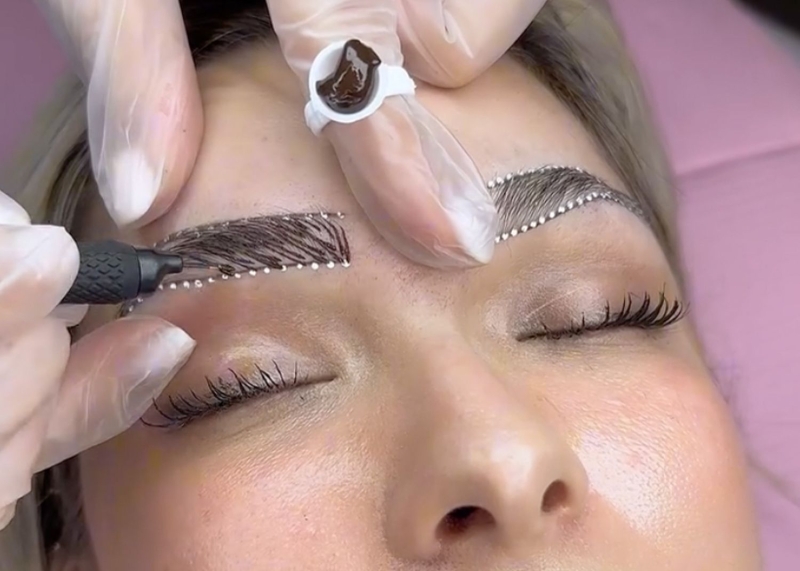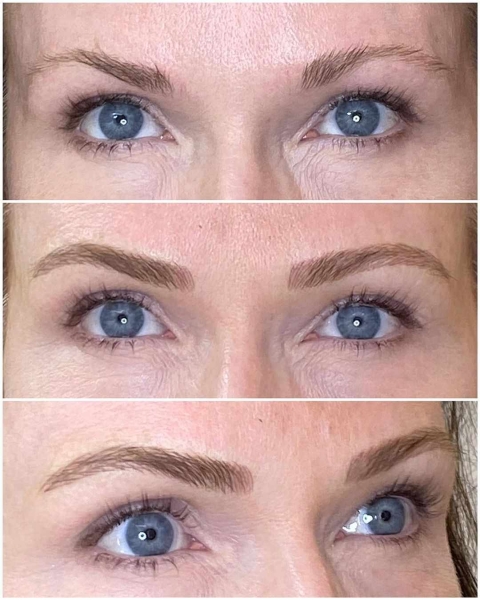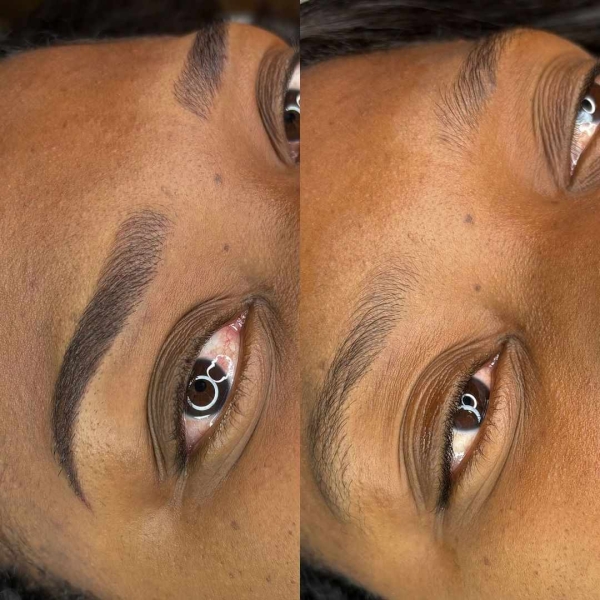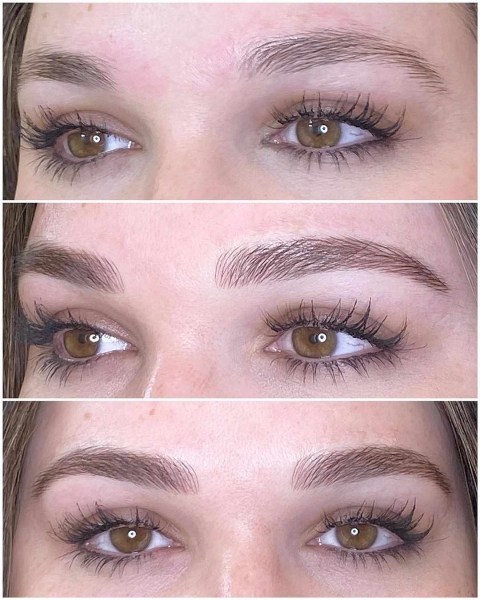Contents

Eyebrows are not supposed to be mirror-image twins of one another — more like sisters. But if your brows don't look like they are from the same genetic pool or need a little help in the shape or fullness department, it may be time to invest in a long-lasting brow treatment like microblading or microshading.
Meet the expert
- Melanie Marris is a celebrity brow stylist and the founder of Brow Code
- Piret Aava, also known as The Eyebrow Doctor, is a cosmetic tattoo specialist, certified esthetician, and makeup artist.
Similar in philosophy but different in technique and results, if you're deciding between microblading and microshading, there's much to consider: your skin tone, the desired effect, and even your dedication level in terms of the upkeep. But both microshading and microblading deliver full, fluffy brows, each with a unique look and finish. Below, brow experts unpack the similarities and differences between microshading and microblading to help you decide which will suit you best.
What is Microblading?

Microblading is a semi-permanent cosmetic tattooing technique used to enhance the eyebrows. During the procedure, a small handheld tool with tiny needles attached creates microscopic cuts in the skin to deposit pigment into the superficial layers of the skin. Microblading aims to mimic the look of natural eyebrow hairs in texture, arch, density, and overall appearance. Marris says that microblading can cover bald spots and fill in sparse brows, reshape them, or add fullness. “There are some incredible artists out there who carefully place each stroke in the right direction so you almost cannot tell that it is not real hair,” she adds. Typically, the results last one year or more, depending on your skin type and aftercare.
While professionally performed microblading is suitable for most skin types, dry and normal skin sees the best results. That's because these skin types are smoother, which allows for more precise, defined strokes during the treatment. "Plus, dry skin typically absorbs pigment more predictably than oily skin," Aava explains, "resulting in more even healing and less patchiness and, therefore, more consistent and longer-lasting results."
Before your microblading appointment, schedule a consultation with your cosmetic tattoo artist (a crucial step!) to discuss the desired brow shape, size, and color. On the day of your appointment, your artist will carefully map out the eyebrow shape and select the pigments that best complement your natural hair color and skin tone for a natural look. Marris recommends asking how the pigment will fade into your skin to understand how your brows will look both immediately after microblading and later on down the road.
You can expect to see the results about four to six weeks after the initial microblading session, which can start at $500 and fetch as much as $2,000. "Keep in mind that periodic touch-up appointments may be needed every six to 12 months to maintain the color and shape of the eyebrows, because the pigment fades over time," Aava says.
What Is Microshading?

While similar to microblading, microshading — also known as "powder" or "ombre brows" — creates a bit of a bolder look, akin to filling the eyebrows with makeup. The semi-permanent makeup technique can improve the look, coloration, and shape of the eyebrows. "Microshading uses a shading technique in a stippling motion to place the pigment into the superficial layers of the skin," Aava says. "The microshading technique results in a soft, powdered-looking brow. It's more of a filled-in look that's subtle yet uniform in appearance." You can expect to pay a little less for microshading than microblading, but not all that much.
Microshading works well on oily, combination, and sensitive skin. Aava says these skin types tend to have a smoother texture than dry skin, making it easier to achieve a soft, powdered effect.
Before your microshading appointment, you'll want to discuss the desired shape, color, and other goals with your cosmetic tattoo artist. "Remember, this is a semi-permanent cosmetic treatment on your face, so always make sure you are in good hands so you feel comfortable with the look and results," Marris says. Using a ruler, the eyebrows are mapped to the desired shape and symmetry, and numbing cream is applied to minimize discomfort. With a handheld tool or a machine with fine needles, your artist will use a stippling or shading motion to deposit the pigment into the skin. "This creates a soft, gradient effect that mimics the appearance of filled-in brows," Marris says.
Immediately after the appointment, the eyebrows will look dark, harsh, and like they are drawn on, which will fade as the eyebrows heal. You may need touch-ups to achieve the desired color, density, and even pigment distribution. With the proper maintenance, your new, fuller-looking brows can last up to three years.
Side Effects of Microblading
For the most part, microblading is safe, but there are potential side effects to be aware of, which include:
- Redness
- Swelling
- Itchy skin
- Scabbing
- Allergic reactions
- Infections
- Patchy or migrating color
It’s normal for just-microbladed skin to scab over and become dry and itchy. No matter what, don’t pick at the scabs and let them fall off on their own. You can apply a healing cream to the brows to help with any itching and discomfort.
Allergic reactions are a rare side effect of permanent makeup, but they can happen. “Some people are allergic to the pigments used in microblading, so always discuss your known allergies with your technician before the procedure,” Aava says. Infections are also uncommon, but they can happen because microblading causes controlled punctures in the skin. To reduce the chances of an infection, follow all the post-procedure instructions.
With microblading, the pigment can turn out uneven, patchy, or even migrate out of the brow area, giving way to blurry-looking eyebrows. Your artist can address this with a corrective appointment.
Side Effects of Microshading
Although major side effects are pretty infrequent with microshading, there are some common post-treatment symptoms, which can include:
- Mild discomfort and tenderness
- Minor swelling and redness
- Dry, flaky, itchy skin
- Scabbing
- Allergic reactions and infections
- Shifts in the deposited pigments
After your microshading appointment, it's typical for the treated area to be somewhat uncomfortable and temporarily swollen, red, and tender. Marris says it's also normal for the eyebrows and surrounding skin to become itchy as the skin heals, which will scab over and flake off for about one to two weeks.
Significant complications after treatment are uncommon, but Marris notes that allergies to the pigments can occur, especially if the pigments contain paraphenylenediamine (PPD), a coloring agent used in permanent hair dyes. Infections are also possible since needles are used. The color of the eyebrows can also morph over time, taking on a red or blue cast. “That’s why it’s imperative to have this procedure done by a trained and experienced professional,” Marris says, “although most clients experience minimal side effects and are satisfied with the results.”
What Happens During Microblading?

Before you lie down for your microblading appointment, there are a handful of prep tips to ensure good results. Avoid blood thinners and aspirin, alcohol, and caffeine, which can increase the risk of bleeding and affect the outcome of microblading. Also, don't expose your skin to the sun pre-microblading because it will make the skin more sensitive to the procedure and hinder normal healing. Aava also suggests skipping retinoids and exfoliants on the brow area for at least two weeks before the treatment, as they can increase skin irritations and cause potential complications.
During a microblading treatment, Marris explains that a handheld tool with tiny needles creates hair-like strokes in the eyebrows by depositing pigment into the skin’s surface layers. “This process mimics the appearance of natural eyebrow hairs and fills in sparse areas,” she says. “At Brow Code, we use a luxury professional pigment line called LI Pigments, developed exclusively for this technique and [it] delivers long-lasting results. We also use LI Pigment Microblading Pens, single-use microblading pens fixed with perfectly angled microblades to achieve ideal pigment implantation.”
After the procedure, it's essential to follow all of the proper aftercare instructions that your artist provides. This typically involves keeping the brow area clean and dry for the first 24 hours, even in the shower, and avoiding sweat-inducing activities. Periodic touch-up appointments are recommended to keep the pigment fresh and ensure long-lasting results.
What Happens During Microshading?
The pre-treatment prep rules for microblading are the same as those for microshading: no sun exposure, blood thinners, retinol, alcohol, caffeine, or exfoliants in the area, since they all have the potential to compromise results.
Typically, microshading is a two-session, two-hour-long treatment using a handheld tool outfitted with tiny needles. With a stippling or shading motion, your cosmetic tattoo artist will use the tool to deposit the pigment into the skin in a dot formation. You may feel some pressure on the area during the treatment — numbing cream can help make this more comfortable — and afterward, the eyebrows will look like they are heavily filled with brow powder or pencil. The results will be more intense in the first two weeks after microshading, but the skin underneath will scab and fall off, leaving the brows looking softer and lighter with more of a powdery finish.
Of course, the longer you can keep your eyebrows dry, the better they will heal properly. The same goes for skipping the sun and keeping harsh acids and skincare ingredients away from them, including alpha hydroxy acids (AHAs), beta hydroxy acids (BHAs), and retinoids.
Choosing the Best Option for You

Microblading and microshading can enhance the look and shape of your eyebrows, but you'll want to consider your skin type when deciding between them. Microblading works well for most skin types, particularly dry and normal skin, while microshading may benefit oily skin more.
Some people want big, bold eyebrows, while others want a natural look. "Microblading generally results in more defined, structured brows, whereas microshading gives a softer, more diffuse appearance for a more natural or filled-in brow look," Aava says. Ultimately, the decision between microblading and microshading depends on individual preferences and what best suits your needs. Aava adds that some people may even combine both techniques, known as "combo brows," to achieve a customized result.
Both microblading and microshading are effective solutions for achieving defined, well-groomed eyebrows with long-lasting results. At the end of the day, Aava says that these eyebrow treatments eliminate the daily hassle of drawing in and shaping the eyebrows with makeup, which will save you time during your makeup routine.

